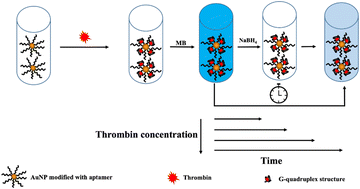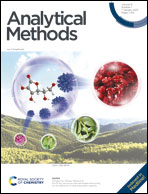An instrument-free visual quantitative detection method based on clock reaction: the detection of thrombin as an example†
Abstract
Instrument-free visual quantitative detection in chemical and biochemical analysis is of great significance in practical applications especially in point-of-care testing and in places where resources are limited. In this paper, we report the development of a time-based instrument-free visual quantitative detection method by employing a clock reaction, a type of chemical reaction displaying characteristic clocking behavior. The feasibility of the method was illustrated by the quantitative detection of thrombin in buffer solution using the lapse of time as the readout signal. The linear range of detection was from 1.3 to 43 nM (r2 = 0.990, n = 3) with a LOD of 0.9 nM, which is lower than the physiological concentrations of thrombin in the resting and activated blood, which range from low nanomolar to low micromolar, respectively. This method was also validated by detecting thrombin in the serum and a good recovery of nearly 100 ± 8.0% was obtained. To the best of our knowledge, this work is the first report that uses the characteristic time of a clock reaction as the readout signal in instrument-free colorimetry for quantitative bioanalysis.



 Please wait while we load your content...
Please wait while we load your content...